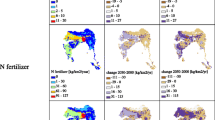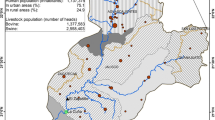Abstract
In contrast with biological processes in lacustrine environments, the physical characteristics of river waters greatly complicate the relationship between nutrient input and primary productivity.
In this paper a new approach to quantify this relationship is developed, linking land use within the watershed to the bioavailability of nutrients in the receiving waters. It estimates by two different ways an enrichment index derived from N/P ratios.
A load model links land-use within the watershed area to nutrient export, and allows the estimation of the potential enrichment index from the ratio of calculated annual exports of nitrogen and phosphorus. This index value correlates well with the real enrichment index representing the annual mean value of the corresponding measured ratios in running waters. The latter index can then be related to nutrient availability expressed by chl-a and the algal growth potential.
This model, established from 7 sampling stations on the Yamaska-North river, allowed assessment of nutrient bioavailability in the river water as a function of hydrological (low or high water flow) as well as of seasonal (summer or winter) events.
Similar content being viewed by others
References
Ravera, O. (ed.): Biological Aspects of Freshwater Pollution, 274p. Proceedings of the Course held at the joint Research Center of the Commission of the European Communities, June 2–5, 1980, Italy, 1979.
Jones, R. A., and Lee, G. F.: Water Res.16, 503–515 (1982).
Lang, D. S., and Brown, E. J.: Appl. Environ. Microbiol.42, 1002–1009 (1981).
Golterman, H.: Prog. Water Techn.12, 63–80(1980).
Duda, M. A.: Water Resour. Bull.18, 397–407 (1982).
Beaulac, M. N., and Reckhow, H. K.: Water Resour. Bull.18, 1013–1024 (1982).
Loehr, R. C.: Prog. Water Tech.11, 169–193 (1979).
Canfield, D. F. Jr.: Water Resour. Bull.19, 255–262 (1983).
Walker, K. F., and Hillman, T. J.: Aust. J. Mar. Freshwater Res.33, 223–243 (1982).
Peterjohn, W. T., and Correll: Ecology65, 1466–1475 (1984).
Haith, D. A., and Shoemaker, L. L.: Water Resour. Bull.23, 471–478 (1987).
Clesceri, N. L., Curran, S. J., and Sedlak, R. I.: Water Resour. Bull.22: 983–990 (1986).
Boot, T. L., Brock, J. T., Dunn, C. S., Naiman, R. J., Ovink, R. W., and Petersen, R. C.: Hydrologia123, 3–45 (1985).
Vannote, R. L., Minshall, G. W., Cummins, K. W., Sedell, J. R., and Cushing, C. E.: Can. J. Fish. Aquat. Sci.37, 130–137 (1980).
Cluis, D., Couillard, D., and Potvin, L.: Water Resour. Res.15, 630–636 (1979).
Statistique Canada. Recensement du Canada—Population Québec,1, (1): 1971a.
Statistique Canada. Recensement du Canada—Agriculture Québec,4 (2): 1971b.
Report of Service de protection de l'environnement industriel du Québec: Projet-cible, Yamaska-Nord. Approche agricole (1ère partie). Service de protection de l'environnement industriel, Québec (1979).
Couture, P., Cluis, D., and Potvin, L.: Annls. Limnol.16, 103–117 (1980).
Vollenweider, R. A.: Scientific fundamentals of the eutrophication of lakes and flowing waters, with particular reference to nitrogen and phosphorus as factors in eutrophication. OECD/DAS/CSI/68.27, 159 p., Paris 1968.
Greene, J. C., Miller, W. E., Shiroyama, T., and Maloney, T. E.: Water, Air, Soil Pollut.4, 415–434 (1975).
Greenberg, A. E., Connors, J. J., and Jenkins, D. (ed.): Standard Methods for the Examination of Water and Wastewater, 14th ed. American Public Health Association, American Water Works Association and Water Pollution Control Federation, Washington, 1975.
Report of United State Environmental Protection Agency: Algal assay procedure, bottle test. National Eutrophication Research Program, EPA, Corvallis, Oregon (1971).
Report of United State Environmental Protection Agency: TheSelenastrum capricornutum Printz algal assay bottle test: experimental design, application, and data interpretation protocol. U.S. Environmental Protection Agency, Oregon, Report No. EPA-600/9-78-018 (1978).
Joubert, G.: Water Res.14, 1759–1763 (1980).
Chiaudani, G., and Vighi, M.: Water Res.8, 1063–1069 (1974).
Ahl, T.: Arch. Hydrobiol. Beih. Ergebn. Limnol.13, 259–277 (1979).
Couture, P.: Doctoral Thesis, Université Paul Sabatier, Toulouse (1981).
Likens, G. E., and Loucks, O. L.: Verh. Internat. Verein. Limnol.20, 568–573 (1978).
Report of Service de la qualité des eaux: Caractérisation de la qualité de l'eau de la rivière Yamaska-Nord: rapport complémentaire. Service de la qualité des eaux, Ministère des Richesses naturelles, Québec (1979).
Carignan, R., and Kalff, J.: Science207, 987–989 (1980).
Carignan, R., and Kalff, J.: Limnol. Oceanogr.27, 419–427 (1982).
Lee, G. F., Rast, W., and Jones, R. A.: Environ. Sci. Technol.12, 900–908 (1978).
Report of Ministère de l'Environnement: Qualité des eaux souterraines du Québec. Service des eaux souterraines, Ministère de l'Environnement, Québec (1979).
Couture, P., Visser, S. A., Van Coillie, R., and Blaise, C.: Schweiz. Z. Hydrol.47, 127–158 (1985).
Greene, J. C., Miller, W. E., Shiroyama, T., Soltero, R. A., and Putman, K.: Proceeding of the Symposium on Terrestrial and Aquatic Ecological Studies of the Northwest, p. 327–336. March 26–27, 1976, EWSC Press, Eastern Washington State College, Washington, 1976.
Greene, J. C., Miller, W. E., Shiroyama, T., Soltero, R. A., and Putman, K.: International Symposium on Experimental Use of Algal Cultures in Limnology, October 1976, Norway (1976).
Wetzel, R. G., in: B. A. Whitton (ed.): Primary Production, p. 230–247. River Ecology. Cambridge, Cambridge University Press, 1975.
Dillon, P. J., and Rigler, F. H.: Limnol. Oceanogr.19, 767–773 (1974).
Brezonik, P. J., Browne, F. X., and Fox, J. L.: Water Res.9, 155–162 (1975).
Bégin, R.: Master's thesis. INRS-Eau, Québec (1985).
Author information
Authors and Affiliations
Rights and permissions
About this article
Cite this article
Cluis, D., Couture, P., Bégin, R. et al. Potential eutrophication assessment in rivers; relationship between produced and exported loads. Schweiz. Z. Hydrol 50, 166–181 (1988). https://doi.org/10.1007/BF02538984
Received:
Issue Date:
DOI: https://doi.org/10.1007/BF02538984




